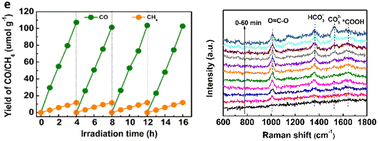Cu-doped mesoporous SnO2 nanoparticles with rich grain boundaries and oxygen vacancies for photocatalytic CO2-to-CO conversion†
Abstract
Photocatalytic conversion of carbon dioxide into fuels provides an effective approach to realize carbon resource utilization. However, the photocatalytic efficiency is still relatively low due to the recombination of photogenerated charges. Herein, we have designed Cu-doped SnO2 nanoparticles (Cu–SnO2) using a glucose-involved hydrothermal crystallization method for the photocatalytic reduction of CO2. The rich oxygen vacancies facilitated the separation and transfer of photogenerated charges, and the confined effect of the typical mesoporous structure promoted the adsorption of CO2, especially a high density of grain boundaries (GBs) and the doping of atomic Cu would introduce new active sites to activate CO2 molecules. This elaborately designed catalyst exhibited super and stable photocatalytic conversion activity of CO2-into-CO, with a CO optimal yield of 107 µmol g−1 in 4 h, which was 2.75 times that over pure SnO2. In situ Raman results indicated that the CO2 reduction reaction followed a *COOH pathway on Cu–SnO2. This work provides implications for the construction of a catalyst with rich defects in the field of energy and environmental catalysis.



 Please wait while we load your content...
Please wait while we load your content...